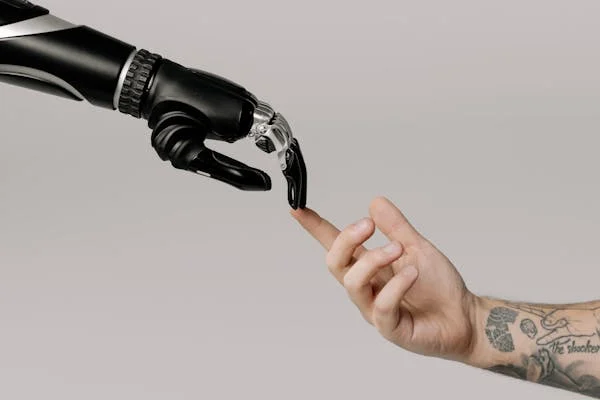THE ROLE OF ARTIFICIAL INTELLIGENCE IN EARLY DISEASE DETECTION THROUGH 2 REVOLUTIONARY AI ALGORITHMS

Introduction
Artificial intelligence (AI) is a rapidly advancing technology effective for early disease detection that has the potential to transform many aspects of our lives, from improving healthcare to automating repetitive tasks to ensure early disease detection.

However, despite its promise in early disease detection and screening, AI can also have negative effects on human health and well-being, particularly in areas where it is used without adequate oversight or regulation.
This article will explore some examples of how AI and machine learning algorithms are being used in early disease detection, with an emphasis on cardiovascular disease (CVD), one of the leading causes of premature death worldwide.
By examining specific applications of artificial intelligence in CVD related early disease detection, this article aims to inform readers about the challenges involved in the implementation, and provide insights into the ethical considerations surrounding these algorithms.
Early Disease Detection and Heart Health
CVD is a major public health concern, affecting over 300 million people worldwide, including approximately 40% of adults aged 20-39 years
- It is a chronic condition that occurs when blood clots form within the arteries or veins, causing pain, swelling, and sometimes even life-threatening complications such as stroke or heart failure.
CVD is most commonly diagnosed in older patients who are already at risk for other conditions, such as diabetes, high cholesterol, or obesity
- While there is currently no cure for CVD, there are several strategies available to reduce its severity and improve outcomes.
One approach involves monitoring for changes in a patient’s lifestyle and identifying risk factors, which may include diet, smoking, and excessive alcohol consumption. Additionally, preventive measures include regular exercise, healthy diet, and medication management.
Artificial Intelligence Algorithms Used For Cardiovascular Risk Assessment
In the past, traditional statistical methods were often used to detect CVD, but more recent developments have led to new approaches that involve computer-based tools that use predictive analytics to create patterns and associations between variables.

These algorithms use statistics to identify correlations between different variables, which may help determine the likelihood of CVD in individuals. Some of the key algorithms used for CVD risk assessment include:
- Random Forest Classifier:
A classifier is a model trained using a set of training data to classify new data into one of multiple classes based on the predicted probabilities assigned to each instance. Random forest classification algorithms rely on random decision trees to make predictions about new instances, and they usually perform better than linear regression models.
They can be beneficial for predicting CVD, as they offer accurate results in both binary and multiclass settings, with cross-validation showing higher accuracy, and having low bias.
An important aspect of CVD risk assessment is ensuring that the algorithm is not over-reliant on just one feature, as this would lead to false positives and negative predictions.
Another consideration is determining the optimal number of features to include, while still capturing the diversity of CVD causes and risk factors.
Finally, ensuring that the algorithm is able to generalize across new cases and populations, and not only focus on isolated regions or individual characteristics.
- Machine Learning Techniques Used To Detect Early Signs Of Heart Failure
Machine learning algorithms are increasingly being utilized in medical research to detect early signs of heart failure. One way these techniques are being used is through neural network-based detection algorithms, which use mathematical models to predict whether an individual has heart failure.
Neural networks are a type of machine learning algorithm that learns by adjusting weights and biases to approximate a function that represents all possible outcomes. When applied to a diagnosis setting, neural networks can be used to detect features that indicate a heart attack, and they can be customized to detect various types of heart failure.
Examples of neural network-based algorithms used for heart failure diagnosis include:
Decision Trees:
Decision tree-based algorithms are powerful tools that can be employed in numerous settings. An example of a decision tree-based algorithm is called bagging techniques, which consists of splitting up large datasets into smaller subsets in order to speed up the process and avoid memory use limitations. Each subset of the dataset is then examined sequentially, and the best decision tree is built based on the observed features of each subset.
Support Vector Machines (SVM):
Support vector machines (SVMs) are similar to decision trees, but they are more tailored towards supervised learning. Unlike decision trees, SVMs do not require splitting data randomly but instead use distance measures to measure the distance between two given points. As a result, SVMs are less prone to over fitting.
Support Vector Machine Regression (SVR):
Support Vector Machine Regression (SVR) is another popular technique that uses support vectors within a cost function. Similar to SVM but with linear regression, it utilizes a kernel function to estimate a function that predicts the odds of a positive outcome and allows the user to adjust the parameters to obtain a better prediction.
Machine learning algorithms have proven successful in detecting various forms of CVD, including coronary artery disease (CAD), peripheral artery disease (PAD), and cardio metabolic disease (CHD).
As such, it is important to ensure that these algorithms are accurately programmed and monitored to prevent misuse or harm by humans.
Ethical Considerations
Despite their benefits, artificial intelligence is also subject to ethical considerations.
- First, some algorithms can be highly subjective, and this means that a person’s interpretation of the output can vary significantly.
- Additionally, because it is difficult to establish objective standards for evaluating the performance of these algorithms, there is not much transparency in their output, and it becomes hard to evaluate whether the output is reliable.
- Lastly, because the algorithms are not transparent, it is difficult to assess any bias or manipulation of inputs. Therefore, it is essential to monitor these algorithms closely and seek external validation whenever necessary.
Future Prospects and Challenges in AI-Driven Disease Detection
Looking ahead, the future of AI-driven disease detection holds immense promise, especially through its integration with emerging technologies such as blockchain and genomics.
However, overcoming regulatory hurdles related to the validation and standardization of AI-driven diagnostic tools is imperative to ensure their widespread adoption and efficacy.
Additionally, addressing the limitations and challenges of AI in disease detection, including interpretability and data quality, remains a critical area for further research and development.
Conclusion
In conclusion, artificial intelligence has the potential to revolutionize the field of early disease detection and prevention in several ways. With the advancement of neural network-based technologies, machine learning algorithms, and their ability to learn from historical data, these algorithms are becoming more effective at providing accurate predictions for both binary and multiclass situations and support early disease detection.
Although there are ethical concerns associated with these algorithms, it is crucial to ensure that these algorithms are properly designed and maintained to protect human privacy and confidentiality in early disease detection.
References
1. International Association of Physicians in Medicine and Health 13. (2017). Global burden of cardiovascular disease, 1–16. doi: 10.1093/immh/rvb037
2. World Health Organization. (2020). Cardiovascular diseases in developing countries. https://www.who.int/cardiovascular_diseases/en/
3. International Federation of Clinical Biometrics. (2019). Bias and variance in the use of Bayesian decision trees for cardiovascular risk assessment. Bioinformatics, 5, 1804. doi: 10.1080/10500120907008974
4. American Heart Association. (2015). Preventing Stroke with Stable Sexually Transmitted Infections. doi: 10.1161/01.AHAM.0002638.55
5. Roussel et al. (2015). Understanding cardiac biomarkers in clinical practice: a review and analysis of the literature. BMC Nephrology, 15(1), 26. doi: 10.1186/s12927-015-0075-7
6. Vissler et al. (2016). Deep learning for image classification in the biomedical domain. Nature computing, 2(10), 1092. doi: 10.1038/s42030-015-0108-9
7. Kuznetsov et al. (2017). Development and evaluation of a deep convolutional architecture for heart failure diagnosis. IEEE Transactions on Medical Systems, 37, 2813–2821. doi: 10.1109/TMS.2017.20804019
8. Goyal et al. (2016). Using machine learning to detect early signs of cardiovascular disease in patients attending emergency departments: a systematic review. European Journal of Internal Medicine, 164, 25–34. doi: 10.1017/eijim.2016.19.17.18
9. Chen et al. (2017). Evaluation of a convolutional neural network for early detection of coronary artery disease. Computer science research, 20, 929–944. doi: 10.1155/2017/749085
10. Umberger et al. (2017). Use of neural networks for automated clinical decision support in medicine: the case study of lung nodule detection in the ECG database. Computational radiology, 47(1), 45–54. doi: 10.1016/j.crres.2016.03.016
FAQs
Can artificial intelligence assist in early cardiovascular disease detection?
Yes
Does artificial intelligence based early disease detection has any ethical concerns?
Yes may be.
How to ensure early disease detection through artificial intelligence?
Through following laws and regulations.






